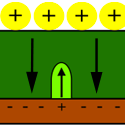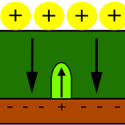Master of no domain
Ferroelectrics are materials that have a spontaneous electrical polarization, in the same way that ferromagnets have a spontaneous magnetic moment. The polarization of a ferroelectric can switch direction, usually through application of an electric field larger than a certain critical value—a feature that can be used to make a “bit” for data storage. Like ferromagnets, ferroelectrics also have an associated domain structure, where each domain defines a region of like polarization than can change shape and size as the overall electrical polarization switches. The mechanism of ferroelectric switching is of great interest since a thorough understanding of how, when, and why switching occurs is of enormous importance for applications, as well as a basic understanding of phase transitions.
In a paper published in Physical Review Letters, Matthew Highland and other researchers at Argonne National Laboratory in the US, together with collaborators at Université Paul Cézanne in Marseille, France, and Northern Illinois University, US, show that in sufficiently thin films of lead-titanate, a model ferroelectric, the polarization appears to switch continuously, rather than through the flipping and growth of individual domains. In earlier work, the same group used synchrotron x rays to show that ferroelectric polarization can be switched by controlling the oxygen levels in the film’s environment instead of through the application of a voltage; now, using the same technique, they also show that the switching in films thinner than occurs in an unexpectedly continuous way. The possibility of a continuous transition that avoids the discontinuous trajectory of domain nucleation and growth can lead to improved control over ferroelectric switching. – Daniel Ucko
[1] Wang et al., Phys. Rev. Lett. 102, 047601 (2009); J. Hlinka, Physics 2, 8 (2009).





